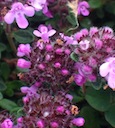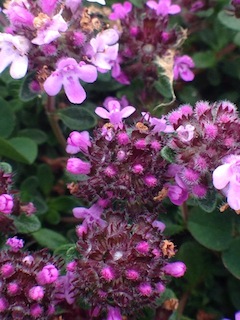 Wild Thyme is one of the plants in full bloom on the Lizard in July.
Wild Thyme is one of the plants in full bloom on the Lizard in July.
Photo: Amanda Scott
Scientific name: Thymus polytrichus
What to look for:
- Flowers: Pale purple flower-heads, about 5 mm across.
- Leaves: Opposite pairs, 4 to 8 mm long
- Height: Low-growing, can grow to some length via underground runners.
- Where: Widespread on calcareous soils, in heath, short grassland, rocks and sand dunes
- When: Wild thyme flowers between May and August
- Habit: Low-growing, creeping, often forming mats
- Similar to: Two other Thyme species are native to Britain – Breckland Thyme and Large Thyme – but neither of these grow in Cornwall
 I know a bank where the wild thyme blows…Oberon’s words from his soliloquy in Shakespeare’s A Midsummer Night’s Dream (Act 2, Scene 1) lend a wistful and warm air to the delicate but profuse flowers of Wild Thyme. This is maybe not undeserved for a plant that comes into its own in mid-summer, when its purple-pink flowers open close to the ground above its creeping stems and mats of leaves. Look out for it growing on heaths, grasslands, rocks and along the clifftops.
I know a bank where the wild thyme blows…Oberon’s words from his soliloquy in Shakespeare’s A Midsummer Night’s Dream (Act 2, Scene 1) lend a wistful and warm air to the delicate but profuse flowers of Wild Thyme. This is maybe not undeserved for a plant that comes into its own in mid-summer, when its purple-pink flowers open close to the ground above its creeping stems and mats of leaves. Look out for it growing on heaths, grasslands, rocks and along the clifftops.
A member of the Dead-nettle family (Lamiaceae), like all of that family it has square stems: Wild Thyme has very slender stems, but you can see the square shape clearly under a hand lens, or feel it by rolling the stem between your fingers. You can also catch a faint thyme scent, although it is not as strong as the species that we use in cooking (Thymus vulgaris – a Mediterranean import).
Wild Thyme is the food plant of the Large Blue butterfly (Maculinea arion), and a number of moth species, including the Thyme Pug (Eupithecia distinctaria).
Did you know…?
…Thymol, the oil that gives Thyme species their scent, is a good antiseptic.
…In folklore, Wild Thyme is believed to one of the flowers most favoured by fairies.
More information and references:
Crafer, T., 2005. Foodplant List for the Caterpillars of Britain’s Butterflies and Larger Moths. Atropos Publishing, Holmfirth, UK.
Mabey, R., 1997. Flora Britannica. Chatto & Windus, London.
Rose, F. and O’Reilly, C., 2006. The Wild Flower Key, 2nd edition. Frederick Warne, London.
Stace, C., 2010. New Flora of the British Isles, 3rd edition. Cambridge University Press, Cambridge.
Published: July 2014
Author: Amanda Scott
Photos: Amanda Scott

